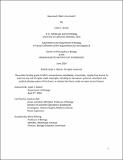How much DNA is too much?
Author(s)
Barker, Juliet C.
DownloadThesis PDF (13.09Mb)
Advisor
Bell, Stephen
Terms of use
Metadata
Show full item recordAbstract
Cells exhibit great diversity in the amount of DNA that they contain, and whole genome duplication events explain much of this diversity. But, whole genome duplication typically obstructs the proliferation of cells in which it occurs. How cells survive and proliferate after DNA content is increased is unknown, and fundamental to understanding the evolutionary success of organisms and cancers. I address this unknown by identifying determinants of cell survival immediately upon whole genome duplication, using budding yeast as a model. I identify the range in number of whole genome duplications (ploidies) that cells can survive. I demonstrate that cell growth accompanies increased ploidy across this range, and that physical determinants alleviating and exacerbating cell surface stress increase and decrease the limit to viable ploidy, respectively. I also identify gene expression changes characteristic of whole genome duplication, immediately as it occurs. In part because recapitulating physiologic effects implied by this signature does not impact the range of ploidies with which cells survive, I propose that ploidy is inherently limited by the impacts of growth in size, which accompany whole genome duplication, to the integrity of the cell surface.
Date issued
2024-05Department
Massachusetts Institute of Technology. Department of BiologyPublisher
Massachusetts Institute of Technology